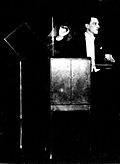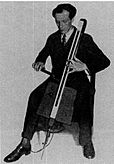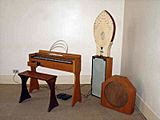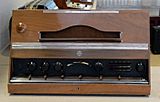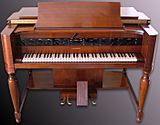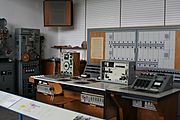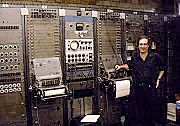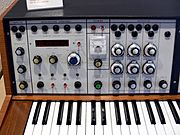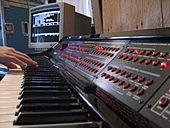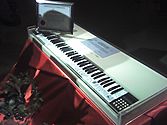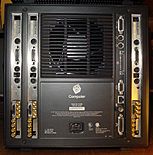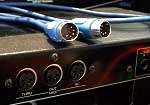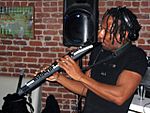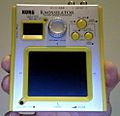Electronic musical instrument facts for kids
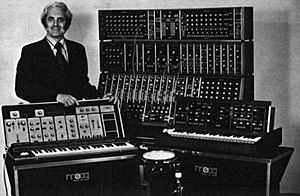
An electronic musical instrument is a special kind of musical instrument. It makes sounds using electronic parts. These instruments create an electrical signal. This signal then goes into a power amplifier and a loudspeaker. That's how we hear the sound!
Many electronic instruments have a way for you to control the sound. You can often change the pitch (how high or low a note is), the frequency, or how long a note lasts. A common way to control them is with a musical keyboard. This works a bit like a piano keyboard. But instead of hammers hitting strings, the keys send signals to a music synthesizer or computer. This then creates the sound.
Sometimes, the part you play (like a keyboard) is separate from the part that makes the sound. These are called a music controller and a music synthesizer. They talk to each other using special languages like MIDI.
Electronic musical instruments are a type of audio signal processing. Simple ones are sometimes called sound effects. It can be hard to tell the difference between a sound effect and a real instrument!
Today, electronic musical instruments are used in almost all types of music. In popular styles like electronic dance music, many sounds come from electronic instruments. Examples include bass synths, synthesizers, and drum machines. Scientists and artists are always inventing new electronic instruments and ways to play them.
Contents
What are Electrophones?
In music studies, electronic musical instruments are called electrophones. They are the fifth main group of instruments in the Hornbostel–Sachs system. Music experts usually call an instrument an electrophone only if electricity is the first thing that makes the sound. This means instruments like an electric guitar are not usually called electrophones. That's because an electric guitar still uses strings to make the first sound, even if it's then made louder by electricity.
This group was added to the Hornbostel-Sachs system in 1940 by Curt Sachs. He divided electrophones into three types:
- Instruments that use electricity to make an acoustic (non-electric) part move. An example is a pipe organ that uses electric controls.
- Acoustic instruments that are made louder by electricity. An example is an acoustic guitar with a pickup.
- Instruments that make sound mainly using electric oscillators. This group includes instruments like the theremin or synthesizers.
Today, many music experts believe that only the third type should be called electrophones. This is because they think the most important thing is what first creates the sound. So, a pipe organ would still be an aerophone (wind instrument). An electric guitar would still be a chordophone (string instrument).
Early Electronic Instruments
In the 1700s, some musicians added electricity to existing instruments. For example, the Denis d'or (1753) and the clavecin électrique (1761) used electricity to change their sound. But electricity wasn't making the sound itself.
The first electric synthesizer was invented in 1876 by Elisha Gray. He called it the "Musical Telegraph." He found he could control sound from an electric circuit that vibrated. This led to a basic oscillator. His Musical Telegraph used steel reeds that vibrated with electromagnets. He even added a simple loudspeaker to later models.
A very important invention was the audion in 1906. This was the first vacuum tube. It helped create and make electrical signals stronger. This led to radio and electronic computers. Other early electronic instruments included the Telharmonium (1897) and the Theremin (1919). The ondes Martenot (1928) and the Trautonium (1930) also appeared.
The ANS synthesizer was built in Russia from 1937 to 1958. Only two were made. The one that still exists is in Moscow. It was used in many Russian movies, like Solaris, to make strange, "cosmic" sounds.
In the 1950s, Daphne Oram created "Oramics." This was a new way to make sounds using drawings on film strips. Her work was used at the BBC Radiophonic Workshop. This workshop also made the famous theme music for the TV show Doctor Who. This music, mostly created by Delia Derbyshire, helped make electronic music popular in the UK.
Telharmonium
In 1897, Thaddeus Cahill invented the Telharmonium. It used spinning metal wheels called tonewheels to make musical sounds. It could create many different notes and sounds. This technology was later used in the Hammond organ. Cahill built three versions. The last one weighed over 200 tons! It was so big it had to be moved by train. By 1912, people lost interest, and Cahill's company went out of business.
Theremin
Another important invention happened around 1919–1920. In Russia, Leon Theremin created the Etherophone, later called the Theremin. This was the first musical instrument played without touching it! You move your hands in the air around antennas to control the sound. This led to the first songs written especially for electronic instruments.
Ondes Martenot
The ondes Martenot was invented in 1928 by French cellist Maurice Martenot. You can play it with a keyboard or by sliding a ring along a wire. It makes "wavering" sounds, a bit like a theremin. Martenot was inspired by the sounds of military radio signals. He wanted to create an instrument that could be as expressive as a cello.
Many composers, like Olivier Messiaen, used the ondes Martenot. It's also been used in many movie and TV soundtracks, especially for science fiction and horror films. Today, artists like Tom Waits and Radiohead's Jonny Greenwood still use it.
Trautonium
The Trautonium was invented in 1928. It could make sounds like bells or gongs. For example, it was used in the 1950s for the bell sounds in the opera Parsifal. In 1942, Richard Strauss used it in his Japanese Festival Music. These new instruments were slow to catch on at first. But by the early 1930s, many new musical works started using them.
Hammond Organ and Novachord
In 1929, Laurens Hammond started his company to make electronic instruments. He created the Hammond organ, which used ideas from the Telharmonium. The Hammond organ is an electromechanical instrument. This means it uses both mechanical and electronic parts. It has spinning metal wheels that create different sounds. These sounds are then sent to an amplifier and speaker.
The Hammond organ was first made as a cheaper option for church music. But musicians soon found it was great for blues and jazz music. A whole style of music, called the organ trio, grew up around it. This usually included a Hammond organ, drums, and another instrument like a saxophone or guitar.
The first synthesizer made for sale was the Novachord. It was built by the Hammond Organ Company from 1938 to 1942. It was very big and heavy, weighing 500 pounds! It could play 72 notes at once. The Novachord was important because it had "envelope control." This allowed musicians to shape how a sound started, lasted, and ended. This feature is a key part of modern synthesizers.
Analog Synthesizers (1950–1980)
The most common electronic instruments are synthesizers. They are called this because they create sounds artificially using different methods. Early synthesizers used analog electronic parts like amplifiers, oscillators, and filters. A big step forward was the invention of the Clavivox synthesizer in 1956 by Raymond Scott.
Modular Synthesizers
In the 1950s, RCA made experimental machines to create voices and music. The RCA Mark II Sound Synthesizer was huge. It filled a whole room! It could only make music by using a paper tape with holes punched in it. This tape controlled the sounds, like a mechanical player piano.
In the 1960s, synthesizers were still very large and mostly used in studios. They were often "modular." This meant they had separate parts that could be connected with wires. Robert Moog created a synthesizer that musicians could actually use. The Moog modular synthesizer was shown in 1964. It was smaller and easier to use than earlier machines. Moog also set standards for how synthesizers would connect and talk to each other. This meant synthesizers from different companies could work together. By the late 1960s, many popular songs used Moog synthesizers. Other early companies making synthesizers included ARP and EMS.
Integrated Synthesizers
In 1970, Moog designed the Minimoog. This was a smaller, all-in-one synthesizer with a built-in keyboard. It was less flexible than the modular ones, but it was much easier to carry and use. The Minimoog sold 12,000 units. It helped set the standard for how future synthesizers would look and work. It became famous for its "fat" sound. These smaller, portable synthesizers quickly became popular in live music and electronic art music.
Polyphony
Many early analog synthesizers were "monophonic." This means they could only play one note at a time. So, you couldn't play chords. Some, like the Moog Sonic Six, could play two notes. Playing many notes at once, called polyphony, was first possible with electronic organs.
By 1976, more affordable polyphonic synthesizers started to appear. These included the Yamaha CS-80 and the Sequential Circuits Prophet-5. These were still big and expensive. But they could save your sound settings in digital memory. This meant you could easily call up your favorite sounds later. The Prophet-5, released in 1977, was the first practical polyphonic synth that could save all settings. This design became a new standard for synthesizers.
Tape Recording
In 1935, a big step happened in Germany. AEG showed the first commercially made magnetic tape recorder, called the Magnetophon. Audio tape was light and had good sound quality. It replaced older, bulkier ways of recording.
The term "electronic music" began to include the tape recorder as a key part. It meant "electronically made sounds recorded on tape and arranged by the composer to make music." It was also very important for a type of music called Musique concrète.
Tape also led to the first keyboards that could play back recorded sounds, called "samples." These included the Chamberlin and the more famous Mellotron. The Mellotron was an electro-mechanical keyboard made in England in the early 1960s.
Sound Sequencers
From the 1940s to the 1960s, Raymond Scott, an American electronic music composer, invented different kinds of music sequencers. A sequencer plays a set pattern of notes. For example, a "step sequencer" might play 16 notes in a row, like 16 steps in a measure. These patterns can then be linked together to make longer songs. Computer programs have been used as sequencers since the 1950s.
Digital Era (1980–2000)
Digital Synthesis
The first digital synthesizers were experiments using computers to make sounds. A method called FM synthesis was created for this. It was a way to make complex digital sounds with less computing power. In 1983, Yamaha released the first stand-alone digital synthesizer, the DX7. It used FM synthesis, which was invented by John Chowning at Stanford University.
The DX7 was compact and affordable. It used special digital chips to make FM sounds. It became the first mass-market all-digital synthesizer. It was very important for many music artists in the 1980s. Yamaha sold over 200,000 DX7s in three years!
The DX7 wasn't easy to program. But it had a clear, percussive sound. It became so popular that it replaced older, heavier instruments like the Rhodes piano. The DX7 was affordable enough for young bands and amateurs to buy. This was different from the expensive synthesizers of the past, which only top professionals could afford.
Sampling
The Fairlight CMI (Computer Musical Instrument) was the first digital sampler that could play many notes at once. It was designed in 1978 in Australia. The Fairlight CMI let musicians change the volume, how a sound started and ended, and add effects like vibrato. You could see sound waveforms on a screen and change them with a light pen. The Synclavier was a similar system. The Kurzweil K250, made in 1983, was also a successful digital synthesizer. It was known for being able to play several instruments at the same time.
Computer Music
A new and important step was using computers to compose music. This was different from just making or changing sounds. Iannis Xenakis started "stochastic music." This was a way of composing using mathematical probability. He used math to create music based on certain rules.
In 1956, Lejaren Hiller and Leonard Issacson wrote Illiac Suite for string quartet. This was the first full piece of music composed with computer help.
In 1957, Max Mathews at Bell Labs wrote the MUSIC-N series. This was the first family of computer programs for making digital audio sounds directly.
MIDI
In 1980, musicians and instrument makers met to create a standard way for new instruments to communicate. This standard was called MIDI (Musical Instrument Digital Interface). It was finalized in 1983.
With MIDI, one press of a key, turn of a wheel, or command from a computer can control many devices in a studio at the same time. Each device responds based on what the composer has set up.
MIDI instruments and software made it much easier and cheaper for many studios and people to control complex instruments. Acoustic sounds could also be brought into studios using sampling.
Modern Electronic Musical Instruments
Today, electronics are more powerful and cheaper, especially personal computers. Also, MIDI and Open Sound Control have become standard ways for instruments to communicate. This has made it easier to separate music controllers (what you play) from music synthesizers (what makes the sound).
The most common music controller is still the musical keyboard. But there are many others! These include the radiodrum, Akai's EWI (a wind controller), and the guitar-like SynthAxe. Other cool controllers are the Buchla Thunder, the Continuum Fingerboard, and the Kaossilator Pro.
Reactable
The Reactable is a round, clear table with a glowing screen. You place and move special blocks called tangibles on the table. You also use your fingers on the screen. This lets you control a virtual modular synthesizer to create music or sound effects.
Percussa AudioCubes
Audiocubes are wireless cubes that have their own computers and batteries. They light up in different colors. They can sense where other cubes are, how they are turned, and how far apart they are. They can also sense your hands and fingers. By playing with the cubes, you can control different music and sound software. AudioCubes are used for making sounds, producing music, DJing, and live performances.
Kaossilator
The Kaossilator and Kaossilator Pro are small instruments. You control the sound by moving your finger on a touch pad. Moving left-right changes the pitch. Moving up-down changes the sound's quality or other settings. The touch pad can be set to different musical scales. The instrument can record a repeating loop of sound. You can then add new layers of sound on top. This is great for electronic dance music.
Eigenharp
The Eigenharp is a large instrument that looks a bit like a bassoon. You can play it using big buttons, a drum sequencer, and a mouthpiece. The sound is made by a separate computer.
XTH Sense
The XTH Sense is an instrument you wear. It uses sounds from your body's muscles (called mechanomyogram) to make music and sound effects. As you move, your muscles make sounds. A small microphone on your arm or leg picks up these sounds. A special computer program then uses these sounds and a library of audio effects. You control the sounds by changing how much force, speed, and movement you use.
AlphaSphere
The AlphaSphere is a round instrument with 48 pads that feel different to touch. They respond to how much pressure you use. Special software lets you program each pad, or groups of pads, to do different things. The main idea of the AlphaSphere is to give electronic musicians more ways to express themselves, like playing a traditional musical instrument.
Chip Music
Chiptune, or chip music, is music where many of the sounds are made or played by a computer or video game console sound chip. This often includes sounds that are like samples or low-quality recordings. Many old video game systems used sound chips to create their music.
DIY Culture
In the late 1970s and early 1980s, people started to "Do It Yourself" (DIY). They would build their own electronic instruments. Magazines would publish designs, and companies would sell kits.
Circuit Bending
Circuit bending is a creative way to short-circuit electronic devices. You might take a child's toy, a guitar effects pedal, or a small digital synthesizer. By changing the circuits inside, you can create new musical instruments or sound generators. This often leads to unexpected and random sounds.
This idea of changing circuits directly was explored by Louis and Bebe Barron in the 1950s. They worked on the soundtrack for the movie Forbidden Planet.
Modern circuit bending often involves taking apart the machine and adding switches or knobs. These parts change the circuit. With more interest in analog synthesizers, circuit bending became a cheap way for experimental musicians to make their own unique sound machines. Today, you can find instructions to build noise generators like the Atari Punk Console. You can also find ways to change toys like the famous Speak & Spell.
Modular Synthesizers
A modular synthesizer is a type of synthesizer made of separate parts that you can swap out. These are also available as kits for people who like to build things themselves. Many hobbyists also sell circuit boards and front panels to others who want to build their own.
2010s and Beyond
In the 2010s, companies like Sixense Entertainment started working on controlling music with motion controllers. Imagine playing music in virtual reality! These "immersive virtual musical instruments" aim to let you see and even feel musical events in a virtual world. This could lead to completely new ways of playing music.
See also
 In Spanish: Instrumento musical electrónico para niños
In Spanish: Instrumento musical electrónico para niños
- Electronic music
- Experimental musical instrument
- Live electronic music
- Visual Music
- Organizations
- STEIM
- Technologies
- Individual techniques
- Chiptune
- Circuit bending
- Instrument families
- Drum machine
- Synthesizer
- Analog synthesizer
- Vocoder
- Individual instruments (historical)
- Electronic Sackbut
- Continuum Fingerboard
- Spharophon
- Individual instruments (modern)
- Atari Punk Console
- Kraakdoos
- Metronome
- Razer Hydra
- Electronic music-instruments in Indian & Asian traditional music
- Electronic tanpura
- Shruti box




